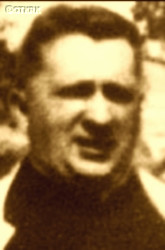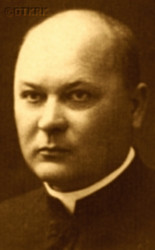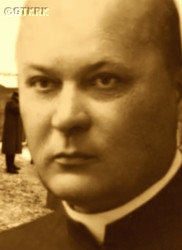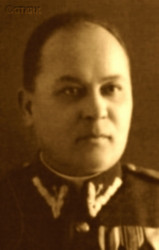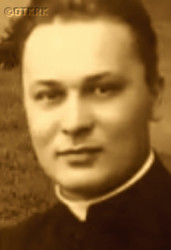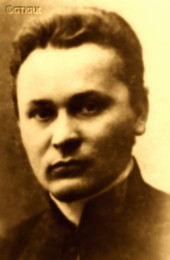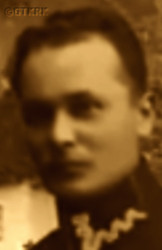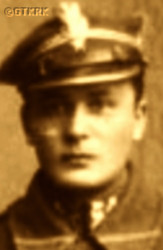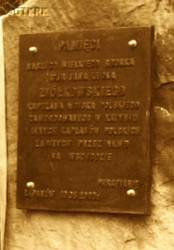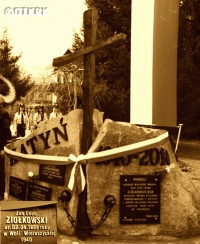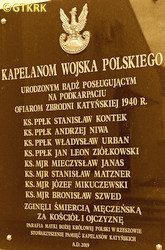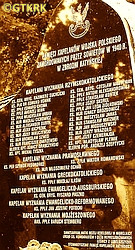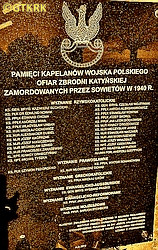Roman Catholic
St Sigismund parish
05-507 Słomczyn
85 Wiślana Str.
Konstancin deanery
Warsaw archdiocese, Poland
full list:
displayClick to display full list

searchClick to search full list by categories
wyświetlKliknij by wyświetlić pełną listę po polsku

szukajKliknij by przeszukać listę wg kategorii po polsku

Martyrology of the clergy — Poland
XX century (1914 – 1989)
personal data
religious status
Servant of God
surname
ZIÓŁKOWSKI
forename(s)
John Leo (pl. Jan Leon)
function
diocesan priest
creed
Latin (Roman Catholic) Church RCmore on
en.wikipedia.org
[access: 2014.09.21]
diocese / province
Cracow archdiocesemore on
en.wikipedia.org
[access: 2013.05.19]
RC Military Ordinariate of Polandmore on
en.wikipedia.org
[access: 2014.12.20]
honorary titles
„Polonia Restituta” Cross — 3rd Class, Commander'smore on
en.wikipedia.org
[access: 2019.04.16]
(c. 29.07.2007)
„For participation in the defensive war of 1939„ Medal
(1998)
September Campaign Crossmore on
pl.wikipedia.org
[access: 2023.11.24]
(01.01.1986, Londontoday: London Cou., England, United Kingdom
more on
en.wikipedia.org
[access: 2024.03.19], decision of George Premyslav Morawicz, Minister of Military Affairs of the Polish Government in exile)
War Order of Virtuti Militari — Silver (5th Class)more on
en.wikipedia.org
[access: 2019.10.13]
(11.11.1976, Londontoday: London Cou., England, United Kingdom
more on
en.wikipedia.org
[access: 2024.03.19], decree of Stanislav Ostrowski, President of the Republic of Poland in exile)
Gold „Cross of Merit”more on
en.wikipedia.org
[access: 2019.04.16]
(07.1939)
Commemorative badge of the Border Protection Corpsmore on
pl.wikipedia.org
[access: 2023.12.15]
(11.1932)
Commemorative Medal on the 10th Anniversary of the Liberation War (Latvia)more on
lv.wikipedia.org
[access: 2023.12.15]
(1929)
Ten Years of Independence Medalmore on
pl.wikipedia.org
[access: 2019.10.13]
(1929)
Commemorative Medal for War of 1918–21more on
pl.wikipedia.org
[access: 2019.10.13]
(1928)
„Cross of Valour”more on
en.wikipedia.org
[access: 2019.04.16]
(10.01.1921)
date and place
of death
08.04.1940

NKVD Katynholiday resort
form.: Kozye Gory forest
today: Smolensk reg., Smolensk oblast, Russia
more on
en.wikipedia.org
[access: 2020.09.24]
alt. dates and places
of death
09.04.1940, 10.04.1940
details of death
In 10.1914, volunteered for the Polish Legions formed in the Austro–Hungarian Imperial Army, but was not accepted.
During the Polish–Russian War of 1919‐1921, a chaplain of the 5th Legions Infantry Regiment (formally assigned on 21.07.1919). Initially, ministered as a chaplain in two military hospitals in Vilnius. Then, set off with the Regiment to the front. Participated in the last battles against the Russians in the Vilnius region in 1919, which led to the announcement by French Marshal Ferdinand Foch of the so‐called demarcation line separating Poland from Lithuania (leaving Vilnius on the Polish side) — prob. was then chaplain of two hospitals in Vilnius. Next took part in the so‐called Latgale campaign, during which initially Poland pushed the Bolshevik Russians beyond the Dvina, and then in 01.1920, in cooperation with the Latvians, captured the Daugavpils fortress and the entire Latgale, leading to the establishment of the independent Republic of Latvia. In 05.1920, took part with his Regiment in the Kiev expedition, on c. 07.07.1920 entering Kiev and leaving it on 10.06.1920 after the start of the Russian offensive. After the retreat (during which the 5th Regiment won a spectacular victory over the Russians in the Battle of Ignatpol), took part in the Polish counterattack from the Wieprz River on c. 14.08.1920, which was part of the Battle of Warsaw (known as the „Miracle on the Vistula”). The counterattack, hitting the southern flank of the Russian northern group, cut it open, splitting the front units from their rear. On 17.08.1920 the Regiment captured Biała Podlaska, on 22.08.1920 took part in the capture of Białystok, after which it chased the Russians to Grajewo and on 25.08.1920 forced some Russian units to cross the border of East Prussia, where they were interned by the Germans. On c. 20.09.1920 it found itself near Grodno, where the second most important battle of the war, the so‐called Battle of the Neman 20‐28.09.1920, was starting, but turned north, towards Sejny, from where the Lithuanians were threatening the Polish counteroffensive. On 22.09.1920 the Regiment attacked Sejny, through the isthmus between the Pomorze and Gieret lakes, near the village of Giby. The application for the Cross of Valor stated: „The Lithuanians secured Giby very strongly, both with infantry and artillery. They welcomed our men with very heavy fire, so that there were many wounded and killed on the spot. Our chaplain, not listening to advice to stay behind, rushed forward to the attacking company 11 and where people were falling to the ground because of the heavy fire, he, standing, blessed the attackers, confessed the seriously wounded and administered the last rites. The soldiers, surprised by the appearance of the chaplain in the hurricane of artillery and machine gun fire, seeing him calm and ignoring the shots, jumped up from the ground and continued attacking the fortified enemy positions”. Sejny was captured the same day. Immediately afterwards, the Regiment moved towards Lida to bypass and relieve the troops fighting at Grodno. The Poles captured Grodno on 26.09.1920, and the Regiment entered Lida on 29.09.1920. The pursuit of the retreating Russians began, through Novgorod to Mir, and from there along the Baranavichy–Minsk railway line. On 03.10.1920 the Regiment captured a Russian armoured train moving along this route. The pursuit ended on 14.10.1920 far to the east, near Radashkovichy, where the announcement of a truce reach the Regiment. From there the Regiment withdrew to Lebedevo near Maladzyechna, to move to Lida in 07.1921.
On 31.12.1921 left the Regiment, but remained a military chaplain on active duty during the Second Polish Republic.
In 08.1939, appointed head of the pastoral service of the 24th Infantry Division of „Karpaty” Army. During the German invasion of Poland, which began on 01.09.1939 (the Russians attacked Poland 17 days later) and the beginning of World War II, ministered in it during whole campaign: from Tarnów, through Pilzno, Strzyżów, Bircza, Przemyśl, Mostyska, Sudova Vyshnya, Yaniv, retreating towards Lviv and taking part in many defensive clashes with the Germans, including near Bircza (11‐12.09.1939). On 18.09.1939, a day after the Russian attack, his Division was defeated near Riasne‐Ruske in the vicinity of Lviv. A small part of the Division managed to get to the encircled Lviv (from c. 20.09.1939 surrounded by the Russians — the Germans withdrew and gave up the occupied areas to the Russians), some tried to break through to the Polish–Hungarian border (and managed to do so, among others, the commander of the Army „Kraków”, Gen. Casimir Sosnkowski).
On 17.09.1939, for unknown reasons, before the final disbandment of the Division, found himself near Ternopil, c. 110 km east of Lviv. That day, the first day of the Russian invasion, the Russians occupied Ternopil and arrested him in Darakhov, c. 25 km east of Ternopil. Perhaps was heading towards Buchach and the Polish–Romanian border.
Initially prob. held captive in the NKVD PFL Yarmolyntsi filtration camp.
From there, in cattle wagons, transported to the NKVD PFL Kozelshchyna filtration camp near Poltava (was there on 15.10.1939).
Next, on 04.11.1939, transported to the NKVD KWL Kozelsk concentration camp.
On 23‐24.12.1939, avoided being transported, along with almost all the clergy held in the camp, to the Butyrki prison in Moscow: instead for celebrating religious services was held — from c. 20.12.1939, for 7 days, i.e. for Christmas — in a punishment cell.
From then on was the only Catholic priest in KWL Kozelsk, secretly extending spiritual care to the prisoners.
From KWL Kozelsk — his name is on the NKVD deportation list No. nr 015/2, item 39 (case No. 1801), prepared in Moscow NKVD HQ on 05.04.1940, with an order to be placed at the disposal of the head of the NKVD Directorate in Smolensk — deported on c. 07.04.1940 (that day was called for transport) to the execution site in the Katyn forest or in the basement of the internal prison of the Regional Directorate of the NKVD in Smolensk, and murdered there. Before execution, was probably massacred by his executioners, which was noticed by the judicial and medical commission during the exhumation carried out in 1943 by the Germans (with the participation of several Poles and foreign observers). His name, at No. AM 487, is included in the German register Germ. „Amtliches Material zum Massenmord von Katyn” (Eng. „Official report on the Katyn mass murder”), released by the Germans in 1943 in Berlin — after the discovery of graves in Katyn — and on the list of the Technical Commission of the Polish Red Cross at No. 487.
By Polish Minister of Defence’s decision No. 439/MON of 05.10.2007 posthumously promoted to the rank of lieutenant colonel.
prisoner camp's numbers
1801 (KLW KozelskClick to display the description)
cause of death
mass murder
perpetrators
Russians
sites and events
NKWD KatynClick to display the description, «Katyn genocide 1940»Click to display the description, KLW KozelskClick to display the description, PFL KozelshchynaClick to display the description, PFL YarmolyntsiClick to display the description, Ribbentrop‐MolotovClick to display the description, Pius XI's encyclicalsClick to display the description, Polish‐Russian war of 1919‐1921Click to display the description
date and place
of birth
02.04.1889Birth certification on:
photos.szukajwarchiwach.gov.pl
[access: 2025.04.13]

Wola Wieruszyckatoday: Łapanów gm., Bochnia pov., Lesser Poland voiv., Poland
more on
en.wikipedia.org
[access: 2021.12.18]
parents
ZIÓŁKOWSKI John
🞲 ?, ? — 🕆 ?, ?

JAROTEK Marianne
🞲 ?, ? — 🕆 ?, ?
baptism
02.04.1889Birth certification on:
photos.szukajwarchiwach.gov.pl
[access: 2025.04.13]

Łapanówtoday: Łapanów gm., Bochnia pov., Lesser Poland voiv., Poland
more on
en.wikipedia.org
[access: 2021.12.18]
St Bartholomew the Apostle RC church
presbyter (holy orders)
ordination
29.06.1913

Krakówtoday: Kraków city pov., Lesser Poland voiv., Poland
more on
en.wikipedia.org
[access: 2021.06.07]
St Stanislav the Bishop and Martyr and St St WenCeslav the Martyr RC cathedral churchmore on
en.wikipedia.org
[access: 2017.11.07] (basillica „on Wawel Hill”)
positions held
16.05.1937 – 1939
RC senior military chaplain — Jarosławtoday: Jarosław gm., Jarosław pov., Subcarpathia voiv., Poland
more on
en.wikipedia.org
[access: 2021.04.01] ⋄ military RC Pastoral District, Corps District OK No. X Przemyśl, Polish Armed Forces ⋄ St Adalbert the Bishop and Martyr RC military parish — head of the District; also: administrator of the military parish
20.09.1930 – 15.05.1937
RC senior military chaplain — Chortkivtoday: Chortkiv urban hrom., Chortkiv rai., Ternopil obl., Ukraine
more on
en.wikipedia.org
[access: 2020.11.20] ⋄ „Podolia” Brigade No. 4, Border Security Corps KOP, Polish Armed Forces ⋄ St Stanislav the Bishop and Martyr RC church — also: military chaplain at the parish church
01.02.1925 – 20.09.1930
RC senior military chaplain — Stanislavivtoday: Ivano‐Frankivsk, Stanislaviv/Ivano‐Frankivsk rai., Stanislaviv/Ivano‐Frankivsk obl., Ukraine
more on
en.wikipedia.org
[access: 2020.11.20] ⋄ military RC Pastoral District, Corps District OK No. VI Lviv, Polish Armed Forces ⋄ St Stanislav the Bishop and Martyr RC military parish — head of the District; also: from 05.1926 administrator of the military parish
01.10.1924 – 01.02.1925
RC senior military chaplain — Lublintoday: Lublin city pov., Lublin voiv., Poland
more on
en.wikipedia.org
[access: 2021.08.20] ⋄ military RC Pastoral District, Corps District OK No. II Lublin, Polish Armed Forces — head of the District
01.10.1922 – 01.10.1924
RC senior military chaplain — Vilniustoday: Vilnius city dist., Vilnius Cou., Lithuania
more on
en.wikipedia.org
[access: 2022.01.06] ⋄ military RC Pastoral District, Corps District OK No. III Grodno, Polish Armed Forces — head of the Region; also: chaplain of garrisons in Vilnius, Grodno and Lida
01.01.1932 – 30.09.1922
RC senior military chaplain — 1st Legions Infantry Division, Polish Armed Forces — titular military pastor; by decree of the Chief of State of 03.05.1922, confirmed with seniority from 01.06.1919 and 27th place on the list of Roman Catholic senior military chaplains, in the rank of major; by L. 3448 decree of the Commander‐in‐Chief of 16.12.1921, verified with seniority from 01.04.1920 and 30th place on the list of Roman Catholic senior military chaplains, in the rank of major
21.07.1919 – 31.12.1921
RC military chaplain — 5th Legions Infantry Regiment, Polish Armed Forces — during the Polish–Russian war of 1919‐1921
01.09.1917 – 01.07.1919
prefect — Krakówtoday: Kraków city pov., Lesser Poland voiv., Poland
more on
en.wikipedia.org
[access: 2021.06.07] ⋄ Ursula Kochanowska's People's School for Girls
01.09.1913 – 01.09.1917
vicar — Babicetoday: Babice gm., Chrzanów pov., Lesser Poland voiv., Poland
more on
en.wikipedia.org
[access: 2021.06.07] ⋄ All the Saints RC parish ⋄ Nowa Góratoday: Krzeszowice gm., Kraków pov., Lesser Poland voiv., Poland
more on
en.wikipedia.org
[access: 2021.06.07] RC deanery — also: prefect of elementary schools
1909 – 1913
student — Krakówtoday: Kraków city pov., Lesser Poland voiv., Poland
more on
en.wikipedia.org
[access: 2021.06.07] ⋄ philosophy and theology, Department of Theology, Jagiellonian University UJ
1909 – 1913
student — Krakówtoday: Kraków city pov., Lesser Poland voiv., Poland
more on
en.wikipedia.org
[access: 2021.06.07] ⋄ philosophy and theology, Theological Seminary ⋄ Kraków RC archdiocese
others related
in death
ALEKSANDROWICZClick to display biography Anthony, CHOMAClick to display biography Edward Anthony, CICHOWICZClick to display biography Nicholas, DRABCZYŃSKIClick to display biography Ignatius Marian (Cl. Dominic), FEDOROŃKOClick to display biography Simon, ILKÓWClick to display biography Nicholas, KONTEKClick to display biography Stanislav, POHORECKIClick to display biography John, POTOCKIClick to display biography John Josaphat, SUCHCICKIClick to display biography Casimir, URBANClick to display biography Vladislav Michael, SZEPTYCKIClick to display biography Andrew Mary Stanislav
sites and events
descriptions
NKWD Katyn: From 03.04.1940 till 12.05.1940 Russians in a planned genocide executed in Katyn c. 4,400 Polish POWs kept in KLW Kozelsk concentration camp in Kozelsk. This genocide was the implementation of the decision of the Russian Commie‐Nazi authorities — the Politburo of the Russian Commie‐Nazi party — of 05.03.1940 to exterminate tens of thousands of Polish intelligentsia and servicemen, held in Russian camps established after the German‐Russian Ribbentrop‐Molotov Agreement and the annexation of half of Poland by the Russians in 1939, known as «Katyn genocide». After the formal „verdict”, the NKVD Special Council Moscow, i.e. the genocidal Russian kangaroo court known as the «NKVD Troika», sent successive disposition letters to the NKVD in Smolensk — there were c. 46 of them — containing the names of the persons to be murdered. The victims were brought by train through Smolensk to the Gnezdowo station in convoys, in groups of 50 to 344 people. From the station to the crime scene, in the so‐called the Kozye Hory area —NKVD recreation center — the victims were transported in a prison bus (known as „chornyi voron”, i.e. black crow). At the site the younger and stronger had military coats put over their heads and their hands were tied behind their backs with a Russian‐made hemp rope, after which they were all killed at short distance with a shot from a 7.65 mm Walther pistol, usually one to the back of the head. Some victims were pierced with a square Russian bayonet. A number of the victims were prob. murdered in the basements of the so‐called internal prison of the NKVD Regional Directorate in Smolensk, where the victims were placed in a sewer manhole, their heads were placed on the bank, and then they were shot in the back of the head. The murdered were buried in eight pits ‐ mass graves. The victims included, among others: Rear Admiral Xavier Czernicki, Generals Bronislav Bohatyrewicz, Henry Minkiewicz and Mechislav Smorawiński, the Chief Orthodox Chaplain of the Polish Army, Lieutenant Colonel Simon Fedorońko, the Chief Rabbi of the Polish Army, Major Baruch Steinberg, 9 Roman Catholic priests, one Greek Catholic and one Evangelical priest, as well as one woman — a pilot Second Lieutenant Janine Lewandowska. (more on: pl.wikipedia.orgClick to attempt to display webpage
[access: 2012.11.23], en.wikipedia.orgClick to attempt to display webpage
[access: 2014.09.21])
«Katyn genocide 1940»: 05.03.1940, the Russian Commie‐Nazi authorities — the Politburo of the Russian Commie‐Nazi party headed by Joseph Stalin — made a formal, secret decision No. P13/144 to exterminate tens of thousands of Polish intelligentsia and military personnel, „declared and hopeless enemies of the Russian government”, held in Russian camps, as a consequence of the German‐Russian Ribbentrop‐Molotov Agreement, the invasion of Poland and annexation of half of Poland in 09.1939, and the beginning of World War II. The decision was, as it were, „sanctioned” by the verdicts of the NKVD Special Council, i.e. the genocidal Russian kangaroo court known as «NKVD Troika» in Moscow. The implementation in Ukraine and Belarus was made possible by order No. 00350 of 22.03.1940 of the head of the NKVD, Lavrentiy Beria, on the „unloading of NKVD prisons”, i.e. transfer of prisoners from several prisons in Ukraine and Belarus to central prisons, e.g. in Kiev or Minsk. The genocidal «NKVD Troika», after issuing sentences, also sent to local NKVD units, NKVD disposition lists — i.e. lists of convicts — each containing on average c. 100 names. Named lists are known — may be reconstructed — for people held in the KLW Kozelsk and KLW Ostashkov camps, but not for KLW Starobilsk, known for victims from Ukrainian prisons, but not Belarusian ones. It is not even known exactly how many lists there were, mainly because the number of them sent to the NKVD in Belarus is unknown. On 03.03.1959 Alexander Shelepin, then head of the Russian KGB, in a handwritten note stated: „ Since 1940, the Committee for State Security under the Council of Ministers of Russia, has been keeping records and other materials relating to the prisoners of war and interned officers, gendarmes, policemen, etc., people from former bourgeois Poland shot that year. In total, based on the decision of the special troika of the NKVD of the USSR, 21,857 people were shot, of whom: 4,421 people in the Katyn Forest (Smolensk Oblast), 3,820 people from the Starobilsk camp near Kharkov, 6,311 people from the Ostashkov camp (Kalinin Oblast), and 7,305 people in other camps and prisons in Western Ukraine and Western Belarus. The entire operation of liquidation of the above–mentioned was carried out on the basis of the Resolution of the Central Committee of the CPSU of 05.03.1940”. The head of the NKVD recommended to the Russian leader, Nikita Khrushchev, to destroy all personal files of those shot in 1940, but to keep the minutes of the meetings of the «NKVD Troika» and confirmations of the implementation of the decisions of the «NKVD Troika». A one–sentence draft resolution was attached to the note. It is not known whether the resolution was accepted and whether the files were destroyed. The aforementioned protocols and confirmations of the «NKVD Troika» are also not known. There are indications — i.e. four so‐called „NKVD‐Gestapo Methodical Conferences” of 1939‐1940: in Brest on Bug, Przemyśl, Zakopane and Cracow — of close collaboration between Germans and Russians in realization of plans of total extermination of Polish nation, its elites in particular — decision that prob. was confirmed during meeting of socialist leaders of Germany: Mr Heinrich Himmler, and Russia: Mr Lavrentyi Beria, in another German leader, Mr Hermann Göring, hunting lodge in Rominty in Romincka Forest in East Prussia. (more on: en.wikipedia.orgClick to attempt to display webpage
[access: 2023.12.15])
KLW Kozelsk: Russian Rus. Концентрационный Лагерь для Военнопленных (Eng. POW Concentration Camp) KLW, run by genocidal Russian NKVD organization, for Poles arrested after the invasion in 1939, operating in 1939‐1940 in Kozelsk — on the premises of the 18th century Orthodox Stauropygial Introduction of the Mother of God into the Temple Optyn Monastery, shut down and robbed by the Russian Bolsheviks in 1923. In 04‐05.1940, c. 4,594 people were detained there, who were then — as part of the implementation of the decision of the Russian authorities to exterminate dozens thousands of Polish intelligentsia and military personnel — murdered in Katyn. The prisoners included one rear admiral of the Polish Navy, four generals, c. 100 colonels and lieutenant colonels, c. 300 majors and c. 1,000 captains and captains of the Polish Army. Around half of them were reserve officers, including: 21 professors, associate professors and lecturers at universities, over 300 doctors, several hundred lawyers, several hundred engineers, several hundred teachers and many writers, journalists and publicists. There was also one woman, 2nd Leutenant pilot Janine Lewandowska. (more on: pl.wikipedia.orgClick to attempt to display webpage
[access: 2012.11.23])
PFL Kozelshchyna: Russian Rus. Проверочно‐Фильтрационный Ла́герь (Eng. Testing and Filtration Camp) PFL, where the genocidal Russian NKVD organization carried out selection and isolation of the most „dangerous” or most valuable prisoners — established after the Russian invasion of Poland on 17.09.1939, the establishment of the NKVD Board for Prisoners of War and Internees on 19.09.1939 by the head of the NKVD, Lavrenty Beria, and the order to establish a number of camps for Polish POWs. Set up c. 500 m from the Kozelshchyna railway station, in the Poltava Oblast in Ukraine, by the Poltava‐Kremenchuk railway line. In 1939, c. 8,000 Polish POWs were held captive prior to being transported to other concentration camps. Police prisoners were kept in tents, rank‐and‐file soldiers in the buildings of the former Orthodox monastery church, shut after the Bolsheviks took power in Russia, and officers were kept in the rest of the church buildings, converted by the Bolsheviks mainly into state farm pigsties (emptied after the pigs died out during the erysipelas epidemic). Everyone was forced to do slave work, according to the principle „those who don't work, don't eat”. According to the survivers, place was cold and they had to queue for hours for water. (more on: www.insignis.plClick to attempt to display webpage
[access: 2023.12.15])
PFL Yarmolyntsi: Russian Rus. Проверочно‐Фильтрационный Ла́герь (Eng. Testing and Filtration Camp) PFL, where the genocidal Russian NKVD organization carried out selection and isolation of the most „dangerous” or most valuable prisoners — established after the Russian invasion of Poland on 17.09.1939, the establishment of the NKVD Board for Prisoners of War and Internees on 19.09.1939 by the head of the NKVD, Lavrenty Beria, and the order to establish a number of camps for Polish POWs. Founded in a Russian military base established in 1935, partially abandoned due to the participation of units stationed there in the war with Poland, located right next to the railway station on the Kamianets‐Podilskyi ‐ Proskuriv line. Up to several dozen thousand Polish prisoners of war were held there, in very difficult conditions, and then, after selection, they sent to other camps. (more on: kuriergalicyjski.comClick to attempt to display webpage
[access: 2023.12.15])
Ribbentrop‐Molotov: Genocidal Russian‐German alliance pact between Russian leader Joseph Stalin and German leader Adolf Hitler signed on 23.08.1939 in Moscow by respective foreign ministers, Mr. Vyacheslav Molotov for Russia and Joachim von Ribbentrop for Germany. The pact sanctioned and was the direct cause of joint Russian and German invasion of Poland and the outbreak of the World War II in 09.1939. In a political sense, the pact was an attempt to restore the status quo ante before 1914, with one exception, namely the „commercial” exchange of the so‐called „Kingdom of Poland”, which in 1914 was part of the Russian Empire, fore Eastern Galicia (today's western Ukraine), in 1914 belonging to the Austro‐Hungarian Empire. Galicia, including Lviv, was to be taken over by the Russians, the „Kingdom of Poland” — under the name of the General Governorate — Germany. The resultant „war was one of the greatest calamities and dramas of humanity in history, for two atheistic and anti‐Christian ideologies — national and international socialism — rejected God and His fifth Decalogue commandment: Thou shall not kill!” (Abp Stanislav Gądecki, 01.09.2019). The decisions taken — backed up by the betrayal of the formal allies of Poland, France and Germany, which on 12.09.1939, at a joint conference in Abbeville, decided not to provide aid to attacked Poland and not to take military action against Germany (a clear breach of treaty obligations with Poland) — were on 28.09.1939 slightly altered and made more precise when a treaty on „German‐Russian boundaries and friendship” was agreed by the same murderous signatories. One of its findings was establishment of spheres of influence in Central and Eastern Europe and in consequence IV partition of Poland. In one of its secret annexes agreed, that: „the Signatories will not tolerate on its respective territories any Polish propaganda that affects the territory of the other Side. On their respective territories they will suppress all such propaganda and inform each other of the measures taken to accomplish it”. The agreements resulted in a series of meeting between two genocidal organization representing both sides — German Gestapo and Russian NKVD when coordination of efforts to exterminate Polish intelligentsia and Polish leading classes (in Germany called «Intelligenzaktion», in Russia took the form of Katyń massacres) where discussed. Resulted in deaths of hundreds of thousands of Polish intelligentsia, including thousands of priests presented here, and tens of millions of ordinary people,. The results of this Russian‐German pact lasted till 1989 and are still in evidence even today. (more on: en.wikipedia.orgClick to attempt to display webpage
[access: 2015.09.30])
Pius XI's encyclicals: Facing the creation of two totalitarian systems in Europe, which seemed to compete with each other, though there were more similarities than contradictions between them, Pope Pius XI issued in 03.1937 (within 5 days) two encyclicals. In the „Mit brennender Sorge” (Eng. „With Burning Concern”) published on 14.03.1938, condemned the national socialism prevailing in Germany. The Pope wrote: „Whoever, following the old Germanic‐pre‐Christian beliefs, puts various impersonal fate in the place of a personal God, denies the wisdom of God and Providence […], whoever exalts earthly values: race or nation, or state, or state system, representatives of state power or other fundamental values of human society, […] and makes them the highest standard of all values, including religious ones, and idolizes them, this one […] is far from true faith in God and from a worldview corresponding to such faith”. On 19.03.1937, published „Divini Redemptoris” (Eng. „Divine Redeemer”), in which criticized Russian communism, dialectical materialism and the class struggle theory. The Pope wrote: „Communism deprives man of freedom, and therefore the spiritual basis of all life norms. It deprives the human person of all his dignity and any moral support with which he could resist the onslaught of blind passions […] This is the new gospel that Bolshevik and godless communism preaches as a message of salvation and redemption of humanity”… Pius XI demanded that the established human law be subjected to the natural law of God , recommended the implementation of the ideal of a Christian state and society, and called on Catholics to resist. Two years later, National Socialist Germany and Communist Russia came together and started World War II. (more on: www.vatican.vaClick to attempt to display webpage
[access: 2023.05.28], www.vatican.vaClick to attempt to display webpage
[access: 2023.05.28])
Polish‐Russian war of 1919‐1921: War for independence of Poland and its borders. Poland regained independence in 1918 but had to fight for its borders with former imperial powers, in particular Russia. Russia planned to incite Bolshevik‐like revolutions in the Western Europe and thus invaded Poland. Russian invaders were defeated in 08.1920 in a battle called Warsaw battle („Vistula river miracle”, one of the 10 most important battles in history, according to some historians). Thanks to this victory Poland recaptured part of the lands lost during partitions of Poland in XVIII century, and Europe was saved from the genocidal Communism. (more on: en.wikipedia.orgClick to attempt to display webpage
[access: 2014.12.20])
sources
personal:
ordynariat.wp.mil.plClick to attempt to display webpage
[access: 2024.12.13], cracovia-leopolis.plClick to attempt to display webpage
[access: 2013.01.26], www.youtube.comClick to attempt to display webpage
[access: 2021.12.19], photos.szukajwarchiwach.gov.plClick to attempt to display webpage
[access: 2025.04.13], www.katolicy.euClick to attempt to display webpage
[access: 2021.12.19], adonai.plClick to attempt to display webpage
[access: 2013.08.10], episkopat.plClick to attempt to display webpage
[access: 2019.10.13], bazhum.muzhp.plClick to attempt to display webpage
[access: 2025.08.19]
bibliographical:
„Register of Latin rite Lviv metropolis clergy’s losses in 1939‐45”, Józef Krętosz, Maria Pawłowiczowa, editors, Opole, 2005
„Biographical lexicon of Lviv Roman Catholic Metropoly clergy victims of the II World War 1939‐1945”, Mary Pawłowiczowa (ed.), Fr Joseph Krętosz (ed.), Holy Cross Publishing, Opole, 2007
original images:
www.radaopwim.gov.plClick to attempt to display webpage
[access: 2012.11.23], www.muzeumkatynskie.plClick to attempt to display webpage
[access: 2017.03.24], www.youtube.comClick to attempt to display webpage
[access: 2021.12.19], pl.wikipedia.orgClick to attempt to display webpage
[access: 2014.12.20], www.youtube.comClick to attempt to display webpage
[access: 2021.12.19], pl.wikipedia.orgClick to attempt to display webpage
[access: 2014.12.20], www.youtube.comClick to attempt to display webpage
[access: 2021.12.19], www.muzeumkatynskie.plClick to attempt to display webpage
[access: 2017.03.24], www.akgrot.wieliczka.euClick to attempt to display webpage
[access: 2017.03.24], www.lapanow.plClick to attempt to display webpage
[access: 2017.03.24], www.lapanow.plClick to attempt to display webpage
[access: 2017.03.24], pamietajskadjestes.plClick to attempt to display webpage
[access: 2023.12.10], radio.lublin.plClick to attempt to display webpage
[access: 2022.05.23], ofm.krakow.plClick to attempt to display webpage
[access: 2022.05.23], www.katedrapolowa.plClick to attempt to display webpage
[access: 2014.01.16], ipn.gov.plClick to attempt to display webpage
[access: 2019.02.02]
LETTER to CUSTODIAN/ADMINISTRATOR
If you have an Email client on your communicator/computer — such as Mozilla Thunderbird, Windows Mail or Microsoft Outlook, described at WikipediaPatrz:
en.wikipedia.org, among others — try the link below, please:
LETTER to CUSTODIAN/ADMINISTRATORClick and try to call your own Email client
If however you do not run such a client or the above link is not active please send an email to the Custodian/Administrator using your account — in your customary email/correspondence engine — at the following address:

giving the following as the subject:
MARTYROLOGY: ZIÓŁKOWSKI John Leo
To return to the biography press below:
 Click to return to biography
Click to return to biography








